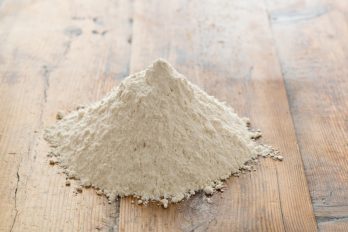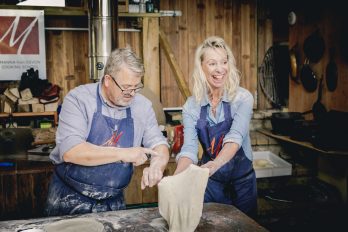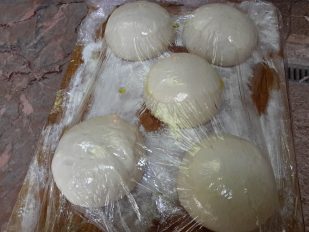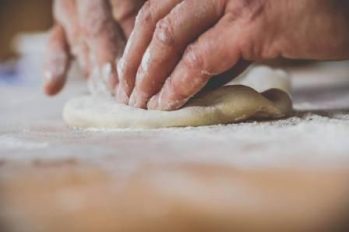Floury doughy woodfired FAQs
On our woodfired cooking courses we always talk a lot about dough and an awful lot about pizza dough. Here are some of the floury doughy woodfired FAQs about pizza flour and dough that we cover that we hope will be of help to those of you who have been with us on a course and those of you still to come. If you aren’t sure of your 00 flour from your semolina, your kneading from your needing, read on and we’re planning to answer all those questions about dough and flour you never knew you had.
So let’s get started with those floury doughy woodfired FAQs !

Woodfired pizzas – unbeatable!!
- What kind of flour do you use? We use 00 flour from Shipton Mill. We buy it in 25kg sacks which get delivered overnight to our door. You can get smaller amounts – they also come in 1kg bags. You can get it from lots of supermarkets and delis too.

Shipton Mill flour – the choice of artisan bakers
- What does 00 mean? This means the flour has been milled twice and is consequently very fine, creating soft and silky dough and light, airy pizzas.

Shipton Mill’s 00 Flour
- What is the protein percentage? The percentage of protein in 00 flour is around 12-13% which means, after a bit of kneading to develop the gluten, the dough will be strong enough to be thrown out by hand without ripping.

strong throwable dough made from 00 flour
- How much flour do I need for a pizza? We work on 100g flour per pizza which gives us dough balls that will make 10-12” pizzas. So if you want to make pizzas for 10 people, that’s a kilo of flour.
- When should I make the dough? We make our dough the night before a class; this means there is one thing less to remember on the morning of a course but it also means the flavour of the dough has had plenty of time to develop along with the gluten. We’ve worked with dough that has been made 96 hours before use and kept in the fridge and it tasted amazing! This was during our visit to Alfa Pizza Ovens in Italy and Guiseppe’s 96 hour dough has become legendary. We aim to make our dough at least 4-5 hours before we want to use it. The longer and slower you let the dough ferment, the better the flavour.
- Once I’ve shaped the dough balls how long before I can use them? Again we let them relax under oiled clingfilm and sitting on flour for a couple of hours so the dough is relaxed and easier to throw or roll to the size we want (this sounds messy but you soon get the hang of it). If it’s a cold day the dough balls will take longer to relax than a warm summer day so you do need to recognise when they are ready and when they need to be used up.

Oil the clingfilm, messy but crucial
- Can I freeze the dough and when should I do so? Yes, yes and thrice yes. The yeast will just become dormant; you won’t kill it if you freeze it. We think the best time to freeze it is when you’ve shaped your dough balls and before they have relaxed. Shape them into dough balls, wrap them in oiled clingfilm and then freeze the dough ball parcels.
- How do I use the frozen dough when I need it? Take the frozen dough balls out of the freezer and let them defrost either in the fridge overnight or at room temperature. Take off the clingfilm and leave them on flour under some oiled clingfilm as in point 6 and let them gradually defrost and rise/relax. Simon at Kernow Forno has a chest freezer of 3000 frozen dough balls and while this may seem excessive for domestic use, it does mean he has a constant supply for his business, making the dough and freezing it during the slacker (?!) midweek days.
- If I just want to keep it in the fridge, how big should the dough be? We’ve found keeping the batches to no more than 1kg in size works for us; any bigger and it takes too long to come back to room temperature. Any smaller and your fridge is just full of containers of dough.
- Do I need to use flour to shape the dough into pizzas? We use plenty of flour to shape the dough into pizza bases. This dries out the surface of the dough and helps prevent it sticking to the pizza peel. Once you’ve shaped the pizza base (think dibble, flop and stretch for those of you who have done the course), shake off any excess flour before you put it on the peel and then get it topped and into the oven quickly. You don’t want an excess of flour on the bottom of the pizza as this will scorch on the oven floor and burn your pizza base.

Dibble, flop and stretch
We hope that answers most of your floury doughy woodfired FAQs. Check out our pizza making video here and our step by step pizza guide. Remember, plenty of practise will develop your skills and your confidence. If you’ve got any more queries we can help with , the bread doctor (David) is always at the end of an email!

The bread doctor is always in!

